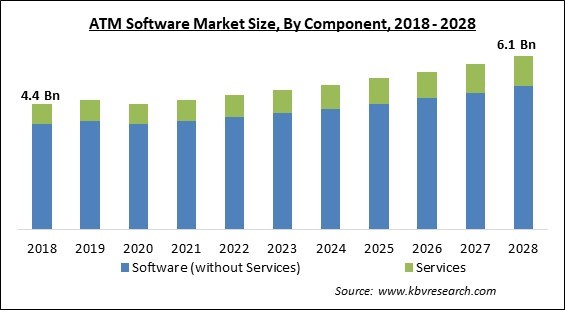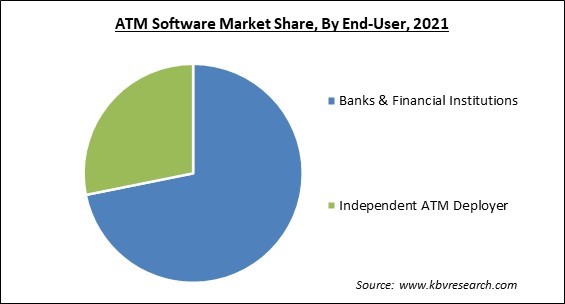The Global ATM Software Market size is expected to reach $6.1 billion by 2028, rising at a market growth of 4.4% CAGR during the forecast period.
The design of an ATM (Automated Teller Machine) combines hardware and software. The hardware of the device is primarily intended for cash deposits, withdrawals, credit card payments, and reporting account information. The ATM's software is made to regulate channels and transactions on centralised databases. Concern over the ATM software stack has grown since the machines were converted to industry standards.

Banks and other financial institutions can manage their ATM networks using ATM software to improve functionality, boost competition, and cut costs. Targeted marketing, cash dispensing & recycling, and advanced banking services like transaction preferences are all aided by it. It makes it possible to significantly cut the cost of implementing, testing, certifying, and maintaining ATM hardware and software upgrades. Through the use of a single software platform, it also offers quicker maintenance and updates, as well as a consistent user interface.
One of the key factors fueling the expansion of the ATM software market is the growing awareness of the advantages of ATM software. The emergence of new technologies like touch screens, cashless transactions, and QR codes, as well as an increase in demand for self-service ATM software across a variety of financial sectors.
The rising demand for contemporary ATM software and hardware and the high adoption of the technology due to the increased use of advanced analytics for preventative maintenance in multivendor ATM support services is rising the need for ATM software.
The ATM software market suffered as a result of the COVID-19 pandemic. In 2020, the pandemic compelled governments of several nations to lock down international borders and temporarily close markets, businesses, and other public areas. The various regions that were in lockdown experienced a loss of revenue and business as a result of the closure of manufacturing facilities. A significant decline in demand and sales of ATM software and services resulted from the disruption of supply chains, which had an adverse effect on the sales, manufacturing, and delivery schedules.
Machine learning is being incorporated into ATM technology in addition to more conventional features like cash dispensing and payment processing to increase efficiency and security. The level of mechanics, machine operation, sensor working patterns, and other discrete information that show how well a system works, streamlines service operations, and predicts problems and machine behavior are also tracked back with the aid of ATM software. AI offers a completely new perspective as well as a wide range of new technologies to ATM system developers, enabling them to create ATM systems with the potential to solve some of the most difficult issues facing the sector.
The demand for ATMs is increased by the independent feature of the 24-7 availability of transactional services offered by banks across numerous locations. With technological advancements in the banking and financial sectors, ATMs are evolving from straightforward cash dispensers into richer and more personalized communication channels. By implementing more integrated and value-added services, has aided in achieving customer loyalty. Therefore, enhanced use of automated teller machines is likely to generate sizable amounts of revenue in the coming years. Owing to this, the ATM software market would expand in the upcoming years.
Previously, there was a much lower chance of fraud because online authorization combined with PIN integration made ATMs seem secure. With increased innovation in the fintech sector, con artists have developed new scams like magnetic stripe skimming and pinhole cameras, which restrain market expansion. However, financial institutions and ATM operators are concentrating on requirements for EMV migration at ATM in order to provide customers with convenience and security while handling financial transactions. As sensitive information appears on the screen, individuals may attempt to spy on users without the user's knowledge. These security issues are the major concern of the people restraining the use of ATMs due to which the ATM software market would be hampered.

Based on component, the ATM software market is segmented into software, and services. In 2021, the software (without services) segment dominated the ATM software market by generating maximum revenue share. This can be attributed to the rise in demand for self-service ATM software across all financial sectors as well as the growing demand for self-service ATM software among end users.
On the basis of end-user, the ATM software market is fragmented into banks and financial institutions, and independent ATM deployer. In 2021, the independent ATM deployer segment covered a substantial revenue share in the ATM software market. This is explained by the rising demand for and usage of ATM software technology in the banking and financial industries. Customers can keep utilizing their old TDM voice equipment without having to buy new Voice over Internet Protocol compatible equipment due to an Integrated Access Device (or IAD).
By function, the ATM software market is divided into bill payment, card payment, cash deposit and cash dispenser. In 2021, the cash dispenser segment led the ATM software market with the largest revenue share. Throughout the forecast period, the cash dispenser segment is anticipated to maintain its market leadership. This is understandable given that ATMs' primary feature is their cash dispenser.
| Report Attribute | Details |
|---|---|
| Market size value in 2021 | USD 4.6 Billion |
| Market size forecast in 2028 | USD 6.1 Billion |
| Base Year | 2021 |
| Historical Period | 2018 to 2020 |
| Forecast Period | 2022 to 2028 |
| Revenue Growth Rate | CAGR of 4.4% from 2022 to 2028 |
| Number of Pages | 180 |
| Number of Tables | 338 |
| Report coverage | Market Trends, Revenue Estimation and Forecast, Segmentation Analysis, Regional and Country Breakdown, Companies Strategic Developments, Company Profiling |
| Segments covered | Component, End-User, Function, Region |
| Country scope | US, Canada, Mexico, Germany, UK, France, Russia, Spain, Italy, China, Japan, India, South Korea, Singapore, Malaysia, Brazil, Argentina, UAE, Saudi Arabia, South Africa, Nigeria |
| Growth Drivers |
|
| Restraints |
|
Region wise, the ATM software market is analyzed across the North America, Asia Pacific, Europe, and LAMEA. In 2021, the North America region witnessed the highest revenue share in the ATM software market. The main factors influencing the market growth in the region include the presence of major market vendors and the high adoption of advanced technologies. The region’s demand is further growing due to government support and initiatives as well as increased funding in the banking sector of nations such as Canada.
Free Valuable Insights: Global ATM Software Market size to reach USD 6.1 Billion by 2028
The market research report covers the analysis of key stake holders of the market. Key companies profiled in the report include Fiserv, Inc., GRGBanking Equipment Co., Ltd., SBS Software Ges.mbH., Paragon Application Systems, Inc., Fidelity National Information Services, Inc., KAL ATM Software GmbH, Vortex Engineering Pvt. Ltd. and CR2
By Component
By End User
By Function
By Geography
The global ATM Software Market size is expected to reach $6.1 billion by 2028.
The Use of Artificial Intelligence (Ai) Becoming an Emerging Trend are driving the market in coming years, however, Insufficient Security Standards restraints the growth of the market.
Fiserv, Inc., GRGBanking Equipment Co., Ltd., SBS Software Ges.mbH., Paragon Application Systems, Inc., Fidelity National Information Services, Inc., KAL ATM Software GmbH, Vortex Engineering Pvt. Ltd. and CR2
The expected CAGR of the ATM Software Market is 4.4% from 2022 to 2028.
The Banks & Financial Institutions market is leading the segment in the Global ATM Software Market by End-User in 2021; thereby, achieving a market value of $4.2 billion by 2028.
The North America market dominated the Global ATM Software Market by Region in 2021; thereby, achieving a market value of $2.0 billion by 2028.
Our team of dedicated experts can provide you with attractive expansion opportunities for your business.

